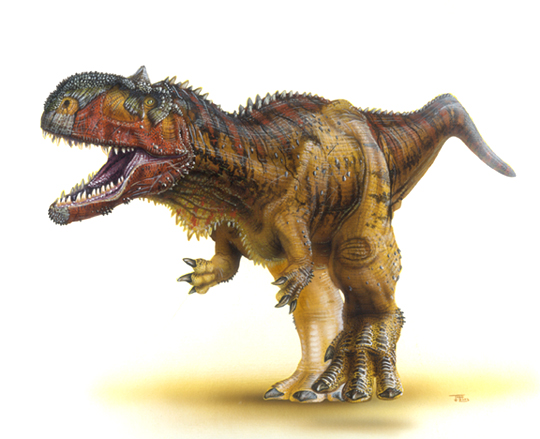- Rajasaurus
Taxobox
name = "Rajasaurus"
fossil_range =Late Cretaceous

image width = 200 pixels
regnum =Animal ia
phylum = Chordata
classis = Sauropsida
ordo =Saurischia
subordo =Theropoda
familia =Abelisauridae
subfamilia =Carnotaurinae
genus = "Rajasaurus"
genus_authority = Wilson "et al.", 2003
subdivision_ranks =Species
subdivision =
* "R. narmadensis" Wilson "et al.", 2003 (type)"Rajasaurus" is a
genus ofabelisaur iancarnivorous dinosaur with an unusual head crest, first described by Chicago paleontologistsPaul Sereno and Jeff Wilson and Geological Survey of India palaeontologist Suresh Srivastava in 2003.Fossilized bones of this species were first discovered by Suresh Srivastava of GSI during 1982-1984 from Rahioli,Kheda district ,Gujarat , India. Bones had also been identified from Lameta Formation (Cretaceous ,Maastrichtian ) nearJabalpur ,Madhya Pradesh in Central India in 1983 by a joint Indo-American group, including members from theUniversity of Michigan ,University of Chicago of the US, and the Panjab University ofIndia , working in India's Narmada valley. The disparity between the fossil sites indicates that the habitat of "Rajasaurus" extended along Narmada river up to Gujarat. "Rajasaurus" was a carnotaurineabelisaur , closely related to other thick-skulled carnivores like the African "Majungasaurus " and the South American "Carnotaurus ". The type specimen of this "princely lizard", which measures 9 meters (30 ft) in length and about 3 meters (10 ft) in height, is housed in the repository unit of GSI at Kolkata. The fossil collection consists of limb bones,vertebra e, pelvic bones,braincase , parts of the lower and upper jaws, teeth, and tail. The discovery represents the first skull ever assembled of a dinosaur of any kind in India. The skull was adorned with a small, double-crested horn made from the nasal and frontal bones.The name "Rajasaurus narmadensis" means "regal lizard from the Narmada." The period of its existence was during the movement of the isolated
tectonic plate that formed the Indian subcontinent, before its collision with theAsia n land mass, which formed theHimalaya s. It also coincides with the end of the dinosaur era.External links
* [http://www.gsi.gov.in/rajasaur.htm "Rajasaurus" article by the Geological Survey of India]
* [http://news.nationalgeographic.com/news/2003/08/photogalleries/rajasaur/index.html "Rajasaurus" article and image gallery at "National Geographic"]
* [http://www.projectexploration.org/news_080303.htm "Rajasaurus" factsheet at Project Exploration]
Wikimedia Foundation. 2010.
